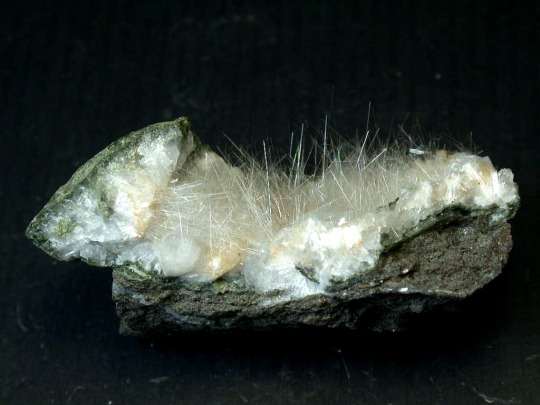#analcime
Text

Analcime Siderite Brookite & Aegirine | Poudrette Quarry, Mont Saint-Hilaire, Québec, Canada
373 notes
·
View notes
Photo




Serandite with Nenadkevichite and Aegirine on Analcime matrix
Locality: Poudrette Quarry, Mont Saint-Hilaire, Montérégie, Québec, Canada
#serandite#nenadkevichite#aegirine#analcime#rock#mineral#gem#crystal#mont saint-hilaire#rocks#minerals#gems#fossils#geology#mineralogy#earth#nature#science
244 notes
·
View notes
Text
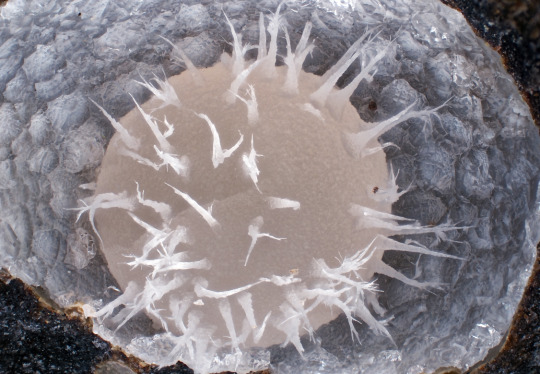
Thompsonite-Ca, Analcime, Faja Grande, Portugal, photo by Miguel Rocha
30 notes
·
View notes
Text



Did some more fusions! Here we now have Analcime (Mica + Sandstone), Dioptase (The one you guys had a poll for, Blue Sandstone + Emerald), and Kämmererite (Yukonite + Spinel)!
#SU fusion#su#SU fanart#Steven universe#analcime#SU oc#Emerald#blue sandstone#sandstone#mica#spinel SU#Yukonite
4 notes
·
View notes
Photo

Analcime and calcite
Pervomaisky quarry (Trudolyubov quarry), Bakhchisarai district, Crimea
Photo: Ekaterina Pakhneva
#Analcime#Calcite#crystals#geology#geo#minerals#mineralogy#mineral specimen#photography#beautiful#april#love#science#earth#nature#natural beauty#natural stone
35 notes
·
View notes
Video
youtube
Analcime
⚒ Location: Mount Kahovan, Moalleman, Qohab-e Rastaq, Amirabad District, Damghan County, Semnan Province, Iran
📸 More photos: https://minerali.rs/2022/02/02/analcime/
More videos: https://www.youtube.com/@Minerali-rs
#crystals#minerals#geology#mineralogy#mineralcollection#gemology#geo#gems#crystal#mineral#rocks#science#earth#nature#natural stone#natural beauty#wonderful#analcime
0 notes
Note
how about a realgar or an analcime for the hot colonies?
I like realgar :0
3 notes
·
View notes
Note

Actinolite Nephrite Adamite Aegerine Afghanite Agate Iris Agate Onyx Sardonyx Agrellite Albite Alunite Amblygonite Analcime Anatase Andalusite Chiastolite Andesine Anglesite Anhydrite Annabergite
Antigorite
Bowenite
Apatite
Apophyllite
Aragonite
Arfvedsonite
Astrophyllite
Atacamite
Austinite
Axinite group:
Ferroaxinite
Magnesioaxinite
Manganaxinite
Tinzenite
Azurite
Baryte
Bastnaesite
Bayldonite
Benitoite
Beryl subgroup:
Aquamarine
Bixbite
Emerald
Goshenite
Golden beryl
Heliodor
Morganite
Beryllonite
Beudantite
Biotite
Boleite
Boracite
Bornite
Brazilianite
Bronzite
Brookite
Brucite
Bustamite
Bytownite
Calcite
Manganocalcite
Caledonite
Cancrinite
Vishnevite
Carletonite
Carnallite
Carnelian
Cassiterite
Cavansite
Celestite
Cerussite
Chabazite
Chalcopyrite
Chambersite
Charlesite
Charoite
Childrenite
Chloromelanite
Chondrodite
Chrysoberyl
Alexandrite
Cymophane
Chromite
Chrysocolla
Chrysoprase
Chrysotile
Cinnabar
Citrine
Clinochlore
Clinohumite
Clinozoisite
Clintonite
Cordierite
Iolite
Corundum
Ruby
Sapphire
Padparadscha
Covellite
Creedite
Cryolite
Cuprite
Danburite
Datolite
Diamond
Bort
Diaspore
Diopside
Dioptase
Dolomite
Dravite
Dumortierite
Elbaite
Emerald
Trapiche emerald Enstatite
Bronzite
Hypersthene
Eosphorite
Epidote
Piemontite
Erythrite
Esperite
Ettringite
Euclase
Eudialyte
Fayalite
Ferroaxinite
Feldspar subgroup:
Andesine
Albite
Anorthite
Anorthoclase
Amazonite
Bytownite
Celsian
Labradorite
Microcline
Moonstone
Orthoclase
Sanidine
Sunstone
Fluorapatite
Fluorapophyllite
Fluorite
Forsterite
Gahnite
Pyralspite
Almandine
Pyrope
Spessartine
Ugrandite
Andradite
Demantoid
Melanite
Topazolite
Grossular
Hessonite
Hydrogrossular
Tsavorite
Uvarovite
Almandine-Pyrope
Rhodolite
rock
diamond coal iron reds stone gold
2 notes
·
View notes
Text
the analcime bit got me close to tears oh my word :')
#ic poor rumi thinking everyone's just being incredibly crass#ooc dammit grizzly#jrwi#jrwi apotheosis#gossamer watches jrwi
3 notes
·
View notes
Text
Beautiful sample of this silicate from the Cantera de Ofita in Calpe, Alicante, Spain; this group of granular analcimated crystals, with forms that are usually between trapezohedral and icositetrahedral crystals, of a brightness between colorless and white, and vitreous with a transparency between opaque and translucent, represent the type of pieces that occur in this area of Valencia, a very suggestive mineral.
0 notes
Text
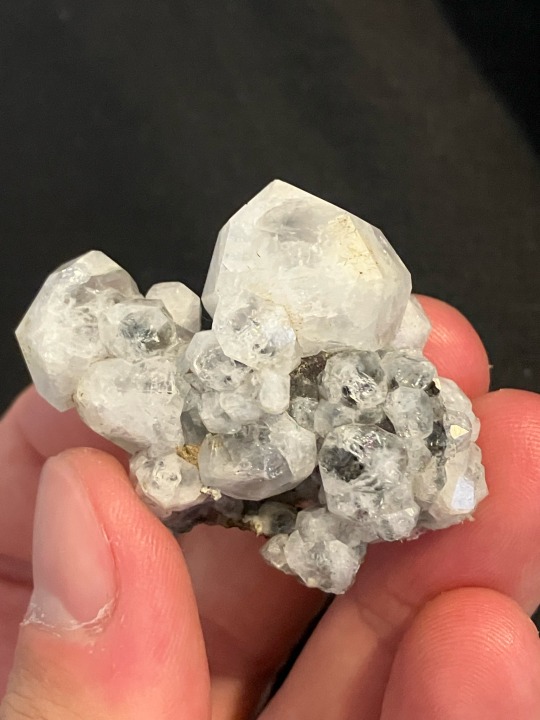
Analcime
(Lmao anal rock)
A sodium aluminiumsilicate that is now glassified as a Zeolite.
The name originates from the Greek ‘analkimos’ which means ‘weak’which isbin reference to the weak electric charge that this mineral produces when heated or rubbed.
Usually colourless (like this specimen) or white however it can also be found in yellow, brown, pink, red or orange.
Silica gel that is used as a desiccant to absorb moisture is usually made from Analcime.
0 notes
Text
Olenite is a rare mineral that can only be found in a few locations in the world, making it relatively unknown and nondescript. Apart from its unique and unusual color – a pinkish orange hue – it is fairly unremarkable.
The true identity of the mineral has been disputed for decades, with some classifying it as analcime (a hydrated sodium aluminosilicate) and some considering it a subset of zeolite. While these two minerals may share a few traits, olenite does not have the same crystal structure as either, giving it its unique characteristics.
Because of its rarity, olenite has remained a mystery for many years. Its presence is scant within known geological processes, consequently not having much opportunity to be observed or studied. As such, its chemical composition and physical properties are largely unknown.
Despite olenite’s non-descript nature, its color has made it a popular choice for jewellery-makers, who prize its unique hue. It has also been mined for use in producing craft items such as tiles and vases.
In recent years, researchers have begun to study olenite more closely, leading to a greater understanding of the mineral's makeup and geologic significance. With a better understanding of its properties, the mineral may become more widely recognized in the future.
0 notes
Text
10 AMAZING ZEOLITE BENEFITS & SIDE EFFECTS

What if you get a “miraculous liquid” that can purify your drinking water, enrich the soil for fertility, and even remove nuclear waste? What if the same liquid can detox your body thoroughly, enhances your gut health, minimizes free-radical damage, boosts your tendency to beat infections, and many more? Well, zeolite can be called that miraculous liquid. Let's learn more about it, even it's not-so-magical aspect.
What is Zeolite?
Zeolite is a highly complex mineral structurally and is formed due to the subsequent reactions that occur when volcanic lava comes in contact with sea-water. This process takes thousands to millions of years to create this super mineral. As per scientists estimates, the first zeolite minerals were formed over 300 million years of time.
“Zeolite” is a single name given to around 240 unique structures that occur in 40+ forms in nature. Its most common types are:
Clinoptilolite
Analcime
Mordenite
Natrolite
Chabazite
Stilbite
Historians say that ancient Romans brought zeolite to use for building bridges during the B.C. period. Then in 1756, a Swedish mineralogist “Axel Cronstedt”, named it and highlighted its competencies for the first time. He described it as hydrated aluminosilicates that have alkaline nature and crystalline structures. It is a conjoint two greek words, i.e. “zéo” which means “boiling” and “líthos” which means “stone.” Since, this mineral compound releases a lot of steam on heating, watching this, it was named “boiling stone”.
Quick Glance
Proponents:
Promotes rapid healing
Provides thorough detoxification
Supports gut health
Supports recovery from diarrhoea
Super antioxidant action
May lower blood cholesterol levels
May enhance the brain and the liver tissue health
Protects and cleanses the skin tissues
Sceptics:
Causes lung damage on inhalation
Interferes with the absorption of certain drugs and nutrients
Poor preparations are contaminated with heavy metals
May be carcinogenic in some forms
Amazing Health Benefits of Zeolite
1. May help in controlling bleeding
Unmanageable bleeding is becoming the 2nd leading death in cases of severe injuries and accidental traumas. Various animal studies suggest that zeolite (clinoptilolite) in combination with clay (CoolClot) may help in a significant reduction in bleeding time when applied topically. However, by promoting early wound healing, it can also help in managing uncontrolled bleeding.
2. Detoxification from heavy metals
Zeolite enhances the elimination of certain harmful heavy metals from our body including arsenic, aluminium, lead, mercury, etc. 30 drops of this mineral compound a day may help in significantly raising the levels of such harmful metals in the urine. Various studies done on mice models, it assisted lead elimination up to 91%, resulting in protecting the brain from associated oxidative damage caused by this heavy metal. Other studies done on animal models, suggested that clinoptilolite promotes aluminium detoxification and prevents it from reaching the bloodstream.
On the other hand, cadmium is also a harmful heavy metal that can potentially cause anemia and impairment of various organ functioning. A study with cadmium-poisoned pigs, suggested that zeolite prevents anemia and protects the liver.
3. Elevates mood & prevents brain damage
Brain cells are very sensitive to certain heavy metal poisonings. These harmful metals can cause irreversible damage to neurons and pave paths to anxiety, anger, depression, and concentration issues. This mineral compound may help in the detoxification of lead, aluminium, mercury, arsenic and many more, thereby relieving the above-mentioned mood disorders.
4. Suppressing alcohol effect
It was seen that in 12 healthy alcohol drinkers, clinoptilolite helped in reducing blood alcohol levels by up to 43%. It even prevented alcohol absorption when consumed with the alcohol. A study of 25 volunteers who consumed zeolite in the morning after having alcohol at night, reported improvement in hangover symptoms by 40-50%.
5. Detoxification of fungal toxins, nitrates, and various radioactive elements
It potentially detoxifies aflatoxins that may contaminate various eatables and endangers our health, particularly the liver. It also helps in eliminating toxins and various dangerous radioactive elements efficiently from our bodies.
6. Enhances gut health
“Leaky gut” is the common name of the condition that denotes the leakage of various toxins, microbes, and inflammation-causing molecules directly into the bloodstream. This may cause chronic fatigue, depression, autoimmune diseases, and etc. Zeolite supplementation may help in the tightening of the intestinal wall, thereby preventing the leaking. It also protects intestinal epithelial cells from the toxic effects of ammonia and helps in repairing the damage caused by the same.
7. Suppresses oxidative damage
Zeolite molecules carry a positive charge. Therefore, these molecules bind with negatively charged free radicals, rendering them ineffective to cause any kind of oxidative damage to the cell walls.
8. Helps in relieving acid reflux and associated stomach ulcers
In the conditions like gastroesophageal reflux disease (GERD), acid reflux may damage the esophageal lining very badly, thereby causing heartburn and other associated symptoms Clinoptilolite form of this mineral compound very effectively relieves heartburn and discomfort by 45-55%. It also helped in healing stomach ulcers caused by NSAIDs or naproxen.
9. Helps in maintaining oral hygiene
The mouth rinses made with zeolite very effectively reduce dental plaque formation, candida growth, or acid formation. It also helps in combating bad breath.
10. Helps in protecting liver cells
The antioxidant action of the zeolite may help in providing liver protection to a great extent.
Side Effects of Zeolite
Although no significant side effects have been reported to date, lung inflammation may occur when it is inhaled.
It’s the capability to bind with heavy metals enhances its concern regarding poisoning from poor and contaminated zeolite supplements.
It is said that this mineral compound may interfere with the absorption of certain drugs and nutrients.
However, this mineral compound has a high affinity to keep those toxins trapped. Some animal studies have suggested its potential to cause gut inflammation.
Certain zeolites like erionite can be cancerous.
One must consult his/her healthcare practitioner while giving it to children, pregnant or breastfeeding females. However, it should be avoided in such cases.
Choosing the Best Zeolite Supplements
While purchasing zeolite supplements, one must go for only 100% natural dietary supplements of it. The question arises here is which supplement we should purchase: powdered or liquid zeolite supplements? The answer lies in the size of the particles of the formulation. The particle sizes in the liquid formulation are usually around 2 microns (nanosized) or even less. These nanoparticles have the potential to cross the blood-brain barrier easily and provide a thorough detoxification of our body including the brain. While most of the powdered supplements of this mineral compound that contain comparatively larger particles have the ability to detox only the gut. Moreover, being smaller in size, liquid zeolite particles get readily absorbed in the bloodstream in comparison to powdered ones containing larger particles.
The crux of the discussion is that if you want to live a toxin-free life with a healthy gut, then zeolite is the apt solution for you.
#zeolite#liquid#detox#vedic#natural#antioxidant#health#detoxification#immunesupport#mineralabsorption#anti-inflammatory#cancerprevention#skinhealth#guthealth#heavymetaldetox#respiratoryhealth
0 notes
Text
Clinoptolite Zeolite Supplier – Industrial Benefits Of Zeolite

What if you know a magic power which purifies the water, enriches the soil and also removes the nuclear waste? What if you came to know that the same powder can detox your body, prevent the body from free-radical damage, boost gut health, fight infections and many more?
Well, are you curious to know what it might be? Then know, that it's the zeolite.
What is zeolite?
Zeolite is a complex mineral which is formed when water comes in contact with volcanic lava. This process usually takes thousands or even millions of years. Scientists usually estimate that the first zeolite mineral was formed over 300 million years ago.
But it's important to know that zeolite is a common name for over 240 unique structures of which more than 40 occur in nature. The most common types of zeolite you can find are clinoptilolite, mordenite, analcime, natrolite, chabazite, natrolite and stilbite. It is said that the ancient Romans used zeolite during B.C. to build bridges.
Zeolite molecular sieves are used in industrial applications for more than 60 years. It is a highly efficient adsorbent used for the separation processes in the gas or liquid phase. Usually, its application range is more which makes it popular. You can get them from the clinoptolite zeolite supplier easily.
The industrial uses for zeolite range from being absorbents for various materials to be a catalyst for many chemical reactions. With these in mind, you have to know the exact benefits of zeolite molecular sieves before getting them from the zeolite molecular sieve manufacturer.
Clinoptolite zeolite supplier – Main industrial uses of zeolite:
Water filtering - The natural zeolite which you can get from the clinoptolite zeolite supplier will be a very good natural filter medium available for the filtration of the water. Its superior performance over the sand and carbon filters makes it the perfect choice to purify the water. As an added advantage, you can get higher throughput rates with less maintenance. It has many advantages over sand and can be used to directly replace the sand in the sand filter.
Catalysis –The industrial uses for zeolite also includes being a catalyst for several important reactions involving organic molecules. The most important reactions are cracking, isomerization and hydrocarbon synthesis. Zeolites usually promote a diverse range of catalytic reactions which includes acid-base and metal-induced chemical reactions. It can also be used for acid catalysts and to support active metals or reagents.
Adsorption – Zeolites which you get from the zeolite molecular sieve manufacturer can also be used to adsorb a variety of materials. It includes applications in purification, drying and separation. They can remove the water to very low partial pressures and effective desiccants with a capacity of up to more than 25% of their weight in the water. They have the ability to remove the volatile organic chemicals from the air streams, a mixture of gases and separate isomers.
Ion exchange – The hydrated cations in the zeolite pores will be bound loosely to the zeolite structure. Hence they will readily exchange with other cations when it is in aqueous media. Applications of it include water-softening devices, detergents and soaps.
Follow Us On Our Social Media Pages
Facebook, Twitter
1 note
·
View note
Text
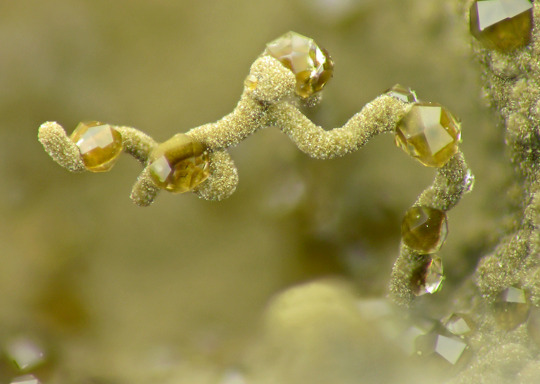

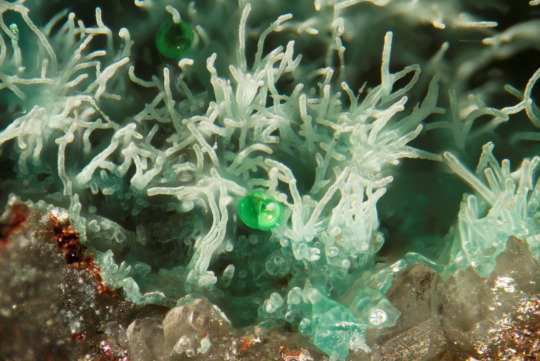
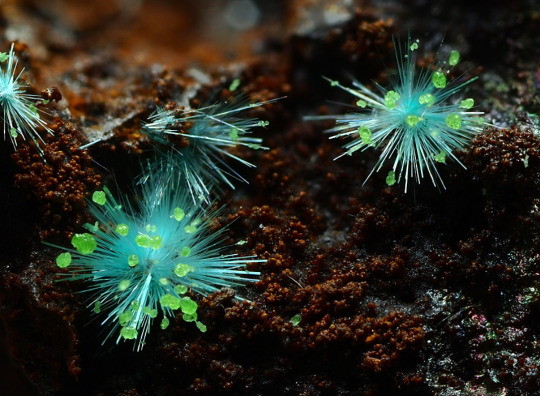
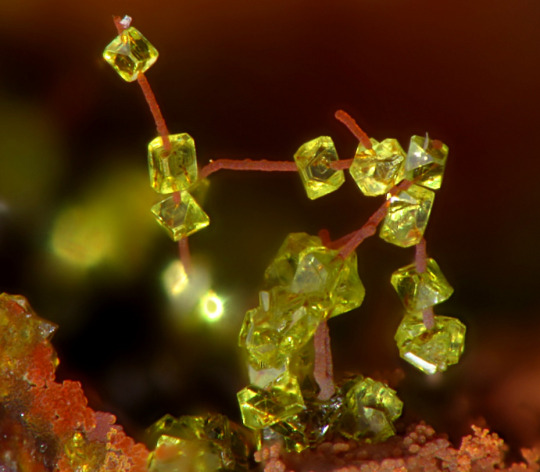




Sealife or Geology?
Analcime, Five Mile Quarry, Washington, Photo by Robert O. Meyer
Carminite, Slipfontein, South Africa, Photo by ROM
Conichalcite, Talmessi Mine, Iran, Photo by Vincent Bourgoin
Agardite- (Nd), Imperial Mine, Nevada, Photo by Yaiba Sakaguchi
Segnitite, Clara Mine, Germany, Photo by IOB Sylvano
Conichalcite, Christiana Mine No 132, Greece, Photo by Alexandros Frantzis
Cuprite, Clara Mine, Germany, Photo by Gerhard Niceus
Petroleum, Quartz, Pakistan, Photo by Danny J. Sanchez
Connellite, Cuprite, Chalcotrichite, Hilarion Mine No 5, Greece, Photo by Alexandros Frantzis
#Geology#mineralology#mineral#microphotography#analcime#carminite#conichalcite#agardite-(Nd)#Segnitite#cuprite#petroleum#quartz#Connellite#Chalcotrichite#Robert O. Meyer#ROM#Vincent Bourgoin#Yaiba Sakguchi#IOB Sylvano#Alexandros Frantzis#Gerhard Niceus#Danny J. Sanchez
968 notes
·
View notes
